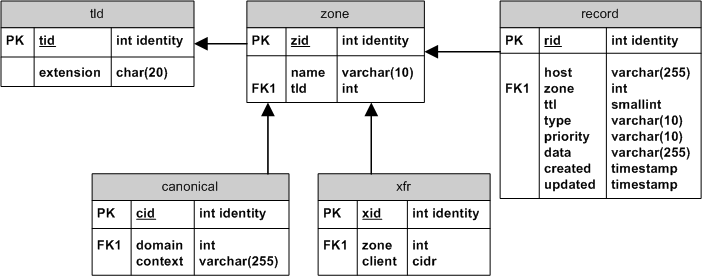Ant Hill Schema

Below is a list of all tables contained within the schema followed by a short explanation
tld
CREATE TABLE tld (
tid serial unique NOT NULL,
extension character varying(20) NOT NULL
);
ALTER TABLE ONLY tld ADD CONSTRAINT tld_pkey PRIMARY KEY (tid);
CREATE UNIQUE INDEX tld_extension_index ON tld USING btree (extension);
This table is merely a list of possible top level domain extensions. The zone names were broken apart to allow a programmer to link prices and/or policies to a certain extension.
zone
CREATE TABLE "zone" (
zid serial unique NOT NULL,
name character varying(255) NOT NULL,
tld integer NOT NULL,
comment text DEFAULT ''
);
ALTER TABLE ONLY "zone" ADD CONSTRAINT zone_id_pkey PRIMARY KEY (zid);
CREATE UNIQUE INDEX zone_name_tld_index ON "zone" USING btree (name, tld);
ALTER TABLE ONLY "zone" ADD CONSTRAINT "$1" FOREIGN KEY (tld) REFERENCES tld(tid);
This table obviously houses all registered domains on your primary name server. Considering the last paragraph this table only contains the name without the tld. A foreign key references to the tld. To ensure data integrity all zone names will be removed if their respective tld is deleted.
record
CREATE TABLE record (
rid serial unique NOT NULL,
host character varying(255) DEFAULT '@'::character varying,
"zone" integer NOT NULL,
ttl integer DEFAULT 21600,
"type" character varying(5),
priority character varying(5) DEFAULT ''::character varying NOT NULL,
data text NOT NULL,
created timestamp with time zone DEFAULT now(),
updated timestamp with time zone DEFAULT now(),
CONSTRAINT record_type CHECK (((((((((((((("type")::text = 'A'::text) OR
(("type")::text = 'AAAA'::text)) OR (("type")::text = 'CNAME'::text))
OR (("type")::text = 'HINFO'::text)) OR (("type")::text = 'MBOXFW'::text))
OR (("type")::text = 'MX'::text)) OR (("type")::text = 'NAPTR'::text))
OR (("type")::text = 'NS'::text)) OR (("type")::text = 'PTR'::text))
OR (("type")::text = 'SOA'::text)) OR (("type")::text = 'TXT'::text))
OR (("type")::text = 'URL'::text)))
);
ALTER TABLE ONLY record ADD CONSTRAINT record_pkey PRIMARY KEY (rid);
CREATE INDEX record_type_index ON record USING btree ("type");
CREATE INDEX record_host_zone_index ON record USING btree (host, "zone");
ALTER TABLE ONLY record ADD CONSTRAINT "$1" FOREIGN KEY ("zone")
REFERENCES "zone"(zid) ON DELETE CASCADE;
This table is made up of the real dns data. It contains the hostnames and the associated data. A foreign key references the associated zone. The constraint from the last passage also applies here. If a zone is removed the associated records will be removed as well.
canonical
CREATE TABLE canonical (
cid serial unique NOT NULL,
"domain" integer NOT NULL,
content text NOT NULL,
FOREIGN KEY ("domain") REFERENCES "zone"(zid) ON DELETE CASCADE
);
ALTER TABLE ONLY canonical ADD CONSTRAINT canonical_pkey PRIMARY KEY (cid);
CREATE UNIQUE INDEX canonical_content_index ON canonical USING btree (content);
Originally this table wasn't present in the schema. The data contained within this table actually causes data redundancy. However, one of the primary demands for a name server is query speed. It is far less efficient to concatenate a tld and a name in a WHERE-clause than to have a table with an already concatenated zone name.
xfr
CREATE TABLE xfr (
xid serial unique NOT NULL,
"zone" integer NOT NULL,
client cidr NOT NULL,
FOREIGN KEY ("zone") REFERENCES "zone"(zid) ON DELETE CASCADE
);
ALTER TABLE ONLY xfr ADD CONSTRAINT xfr_pkey PRIMARY KEY (xid);
CREATE UNIQUE INDEX xfr_zone_client_index ON xfr USING btree ("zone", client);
This table lists the allowed transfers of zones for certain clients. This table will allow a customer to specify a separate name server to run as a secondary for a domain.
